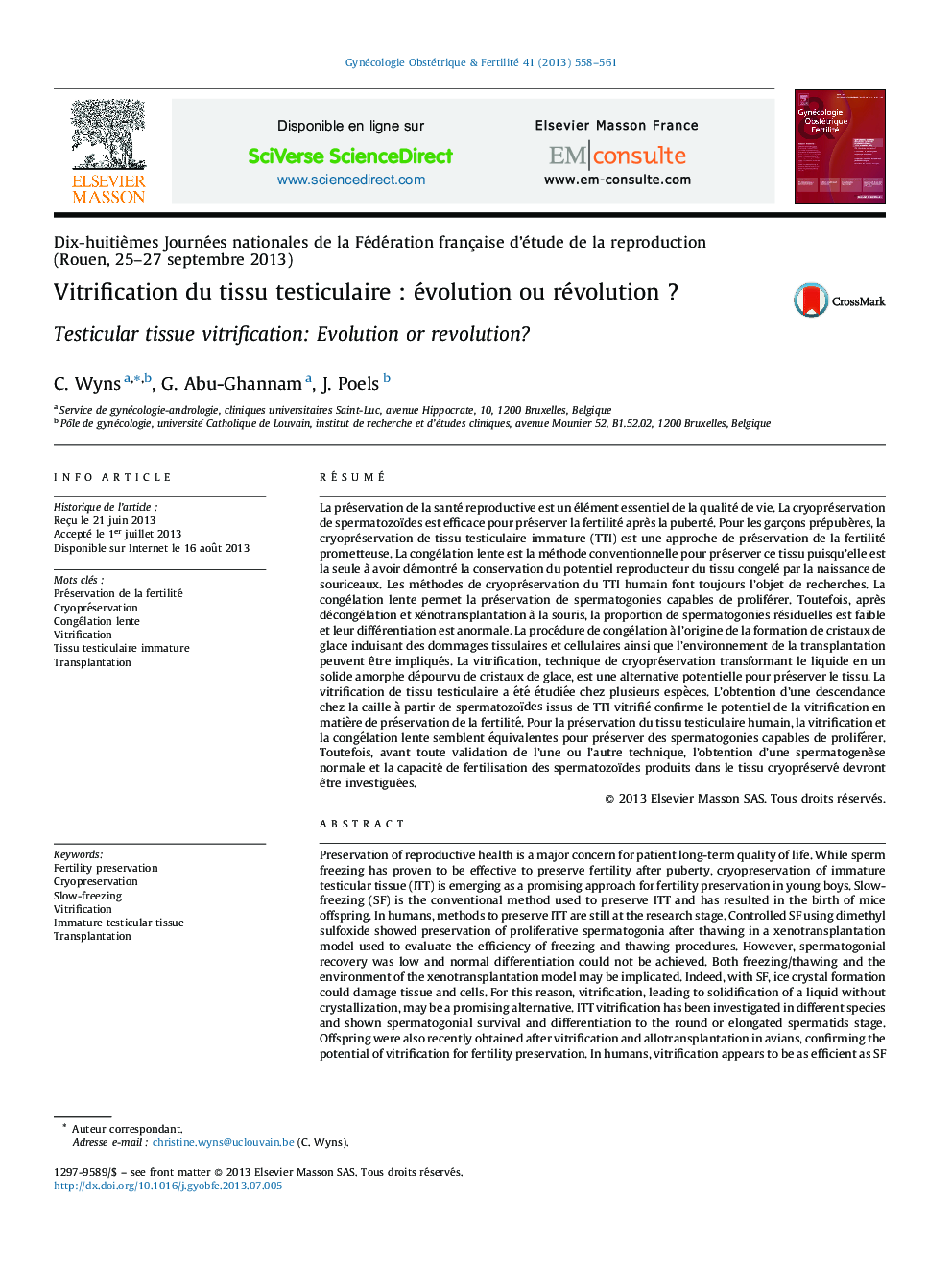| کد مقاله | کد نشریه | سال انتشار | مقاله انگلیسی | نسخه تمام متن |
|---|---|---|---|---|
| 3951635 | 1254879 | 2013 | 4 صفحه PDF | دانلود رایگان |

RésuméLa préservation de la santé reproductive est un élément essentiel de la qualité de vie. La cryopréservation de spermatozoïdes est efficace pour préserver la fertilité après la puberté. Pour les garçons prépubères, la cryopréservation de tissu testiculaire immature (TTI) est une approche de préservation de la fertilité prometteuse. La congélation lente est la méthode conventionnelle pour préserver ce tissu puisqu’elle est la seule à avoir démontré la conservation du potentiel reproducteur du tissu congelé par la naissance de souriceaux. Les méthodes de cryopréservation du TTI humain font toujours l’objet de recherches. La congélation lente permet la préservation de spermatogonies capables de proliférer. Toutefois, après décongélation et xénotransplantation à la souris, la proportion de spermatogonies résiduelles est faible et leur différentiation est anormale. La procédure de congélation à l’origine de la formation de cristaux de glace induisant des dommages tissulaires et cellulaires ainsi que l’environnement de la transplantation peuvent être impliqués. La vitrification, technique de cryopréservation transformant le liquide en un solide amorphe dépourvu de cristaux de glace, est une alternative potentielle pour préserver le tissu. La vitrification de tissu testiculaire a été étudiée chez plusieurs espèces. L’obtention d’une descendance chez la caille à partir de spermatozoïdes issus de TTI vitrifié confirme le potentiel de la vitrification en matière de préservation de la fertilité. Pour la préservation du tissu testiculaire humain, la vitrification et la congélation lente semblent équivalentes pour préserver des spermatogonies capables de proliférer. Toutefois, avant toute validation de l’une ou l’autre technique, l’obtention d’une spermatogenèse normale et la capacité de fertilisation des spermatozoïdes produits dans le tissu cryopréservé devront être investiguées.
Preservation of reproductive health is a major concern for patient long-term quality of life. While sperm freezing has proven to be effective to preserve fertility after puberty, cryopreservation of immature testicular tissue (ITT) is emerging as a promising approach for fertility preservation in young boys. Slow-freezing (SF) is the conventional method used to preserve ITT and has resulted in the birth of mice offspring. In humans, methods to preserve ITT are still at the research stage. Controlled SF using dimethyl sulfoxide showed preservation of proliferative spermatogonia after thawing in a xenotransplantation model used to evaluate the efficiency of freezing and thawing procedures. However, spermatogonial recovery was low and normal differentiation could not be achieved. Both freezing/thawing and the environment of the xenotransplantation model may be implicated. Indeed, with SF, ice crystal formation could damage tissue and cells. For this reason, vitrification, leading to solidification of a liquid without crystallization, may be a promising alternative. ITT vitrification has been investigated in different species and shown spermatogonial survival and differentiation to the round or elongated spermatids stage. Offspring were also recently obtained after vitrification and allotransplantation in avians, confirming the potential of vitrification for fertility preservation. In humans, vitrification appears to be as efficient as SF in terms of spermatogonial survival and initiation of differentiation after xenotransplantation. However, before validation of such fertility preservation methods, completion of normal spermatogenesis and the fertilization capacity of sperm retrieved from cryopreserved and transplanted tissue should be fully investigated.
Journal: Gynécologie Obstétrique & Fertilité - Volume 41, Issue 9, September 2013, Pages 558–561